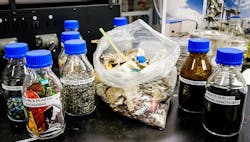Plastic Waste Yields Hydrogen And Nanotubes
Researchers at Nanyang Technological University (NTU), Singapore, have developed a two-stage process to convert waste plastic into hydrogen and carbon nanotubes. It especially targets difficult-to-recycle plastic litter containing contaminated food packaging, polystyrene foam and plastic bags. While applicable anywhere, the process particularly promises to help Singapore deal with the about 868 million kg of waste plastic annually generated there; currently only 4% of that is recycled, with most of the rest incinerated.
The first stage of the NTU process involves high-temperature thermal decomposition of plastic waste into a syngas that also contains low concentrations of hydrogen molecules.
In the second stage, the gases enter another reactor filled with an unspecified catalyst. There, hydrogen gas is produced and carbon nanotubes are synthesized via a chemical vapor deposition process. The nanotubes then can be purified and functionalized using water-free techniques, allowing for efficient metal recovery and avoidance of liquid waste, note the researchers. Functionalized nanotubes in a powdered form are ideal for many uses including batteries, coatings and films, they add.
The researchers say their pilot, laboratory-based reactor can produce 70–150 kg of hydrogen and 700–800 kg of solid carbon from 1,000 kg of plastic waste.
“The novelty of our invention is actually not the pyrolysis system that converts plastics into gases, but that we can convert these gases into solid carbon using our catalyst. So we are looking to convert waste plastics that cannot be recycled into high-value chemicals and resources, such as hydrogen fuel, synthetic fuel that could replace petrol [gasoline], and carbon nanotubes used for many industrial applications,” explains associate professor Grzegorz Lisak from NTU’s Nanyang Environment and Water Research Institute.
The multimillion-dollar research joint project, supported by Singapore’s Industry Alignment Fund-Industry Collaboration Projects, aims to develop feasible solutions to economically scale up the conversion of waste plastics to hydrogen over the next three years.
To further refine the new conversion method and assess its commercial feasibility, the research team is test-bedding it on the NTU Smart Campus to treat local plastic waste, in partnership with Bluefield Renewable Energy (BRE), Singapore, an environmental firm that specializes in mobile waste-to-resources technologies.
BRE is bringing to the test bed knowhow developed from its own flexible pyrolysis process called Thermo Disintegration Waste to Resource (TDWR), which already is deployed commercially in Singapore. That technology can handle feeds including biomass, gardening and food wastes, as well as discarded plastics such as polyethylene and polypropylene. TDWR breaks down the wastes in a reactor running at 900–1,000°C to produce biochar, syngas and electricity.
